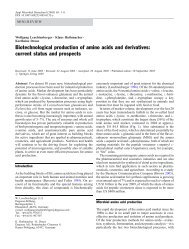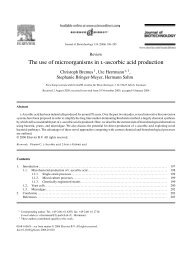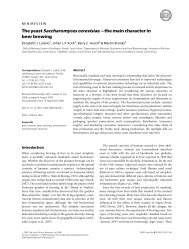The yeast Kluyveromyces marxianus and its ... - It works!
The yeast Kluyveromyces marxianus and its ... - It works!
The yeast Kluyveromyces marxianus and its ... - It works!
You also want an ePaper? Increase the reach of your titles
YUMPU automatically turns print PDFs into web optimized ePapers that Google loves.
342 Appl Microbiol Biotechnol (2008) 79:339–354<br />
present in K. <strong>marxianus</strong>; the use of microcalorimetry for<br />
identification purposes; <strong>and</strong> the characterization of coenzyme<br />
Q <strong>and</strong> monosaccharide patterns of cell walls (Table 1).<br />
In other cases, K. <strong>marxianus</strong> wassimplyusedasthe<br />
source of specific compounds, which were the actual focus of<br />
research (mainly enzymes). Examples of this kind of study<br />
include those on fructose-1,6-bisphosphatase, uridine diphosphate<br />
(UDP) glucose-4-epimerase, an acid phosphatase, an<br />
amine oxidase, protein phosphatases, carboxypeptidases, <strong>and</strong><br />
aminopeptidases (Tables 1 <strong>and</strong> 2). A number of transport<br />
studies were also carried out, namely, on the transport of<br />
sugars (lactose, glucose, fructose, galactose, <strong>and</strong> xylose) <strong>and</strong><br />
organic acids (lactic <strong>and</strong> malic acids) (Table 1). Finally, a few<br />
metabolic studies were carried out with the aim of<br />
characterizing some non-transport aspects of K. <strong>marxianus</strong>,<br />
such as the absence of complex I in the respiratory chain, the<br />
regulation of adenilate cyclase by Ras proteins, the functional<br />
characterization of Mig1p (involved in glucose repression),<br />
analysis of cell-wall composition, presence of efflux pumps<br />
<strong>and</strong> their role in drug resistance, <strong>and</strong> the regulation of the<br />
nicotinamide adenine dinucleotide phosphate (oxidized form)<br />
(NADP + )-dependent glutamate dehydrogenase (Table 1). In<br />
many cases, these studies were performed in parallel with<br />
other <strong>yeast</strong>s, mainly with S. cerevisiae.<br />
In terms of biochemical studies on enzymes that have<br />
industrial interest, K. <strong>marxianus</strong> has been used as a source<br />
of inulinase, β-galactosidase, β-glucosidase, <strong>and</strong> endopolygalacturonases<br />
(Table 2). Besides these, some less widespread<br />
enzymes with potential industrial application, such as<br />
protein phosphatases, carboxypeptidases, <strong>and</strong> aminopeptidases<br />
have also been investigated more recently (Table 2).<br />
In the 1970s, physiological studies focusing on the<br />
influence of some common environmental factors on the<br />
growth of K. <strong>marxianus</strong> started to appear in the literature,<br />
as a reflection of the eventual interest in using this <strong>yeast</strong> for<br />
industrial applications. Chassang-Douillet et al. (1973)<br />
presented the first clear physiological comparison of K.<br />
<strong>marxianus</strong> <strong>and</strong> S. cerevisiae, carried out using synthetic<br />
media <strong>and</strong> demonstrating that the so-called glucose effect<br />
was absent in K. <strong>marxianus</strong>, as opposed to S. cerevisiae.<br />
Later studies reported on the effects of pH (de Sánchez <strong>and</strong><br />
Castillo 1980), ethanol concentration (Bajpai <strong>and</strong> Margaritis<br />
1982), <strong>and</strong> sugar concentration (Margaritis <strong>and</strong> Bajpai 1983)<br />
on the growth kinetics of K. <strong>marxianus</strong>. Importantly, K.<br />
<strong>marxianus</strong> started to be included in comparative biochemical<br />
<strong>and</strong> physiological studies on <strong>yeast</strong> in general, such as those<br />
related to catabolite repression (Eraso <strong>and</strong> Gancedo 1984),<br />
sensitivity toward toxins (Sukroongreung et al. 1984), <strong>and</strong><br />
growth inhibition by fatty acids (Viegas et al. 1989).<br />
<strong>The</strong> use of defined synthetic media combined with chemostat<br />
cultivations for quantitative physiological studies started<br />
around the 1990s, with <strong>works</strong> focusing on the regulation of<br />
respiration <strong>and</strong> fermentation <strong>and</strong> on the so-called Crabtreeeffect<br />
in <strong>yeast</strong>s (van Urk et al. 1990; Verduyn et al. 1992). <strong>It</strong><br />
was then quantitatively shown that K. <strong>marxianus</strong> presents a<br />
strong Crabtree-negative character, since no ethanol production<br />
was observed after a glucose pulse applied to respiring<br />
cells, in contrast to what is commonly observed with S.<br />
Table 2 Studies on the biochemistry of enzymes of industrial interest performed with the <strong>yeast</strong> K. <strong>marxianus</strong><br />
Enzyme Application Strain Reference<br />
Inulinase Production of fructose<br />
syrup from inulin-containing<br />
feed-stocks<br />
β-galactosidase Reduction of lactose<br />
content in foods<br />
K. fragilis ATCC 12424;<br />
K. <strong>marxianus</strong> CBS 6397,<br />
CBS 6556<br />
K. fragilis (several strains);<br />
K. <strong>marxianus</strong> NCYC 111;<br />
K. <strong>marxianus</strong> ATCC 10022;<br />
K. <strong>marxianus</strong> IMB3; K.<br />
<strong>marxianus</strong> CBS 6556<br />
Workman <strong>and</strong> Day (1984);<br />
Rouwenhorst et al. (1988, 1990a,b)<br />
Mahoney et al. (1975); Gonçalves <strong>and</strong><br />
Castillo (1982); Bacci Júnior et al.<br />
(1996); Brady et al. (1995); Martins<br />
et al. (2002)<br />
β-glucosidase Hydrolysis of cellulosic materials K. fragilis ATCC 12424 Raynal <strong>and</strong> Guerineau (1984);<br />
Leclerc et al. (1987)<br />
Endopolygalacturonases Reduce of viscosity in fruit K. <strong>marxianus</strong> CCT 3172; CCT Jia <strong>and</strong> Wheals (2000)<br />
processing products<br />
3172 (overproducing mutant);<br />
an unidentified NCYC isolate<br />
Protein phosphatases modification of cheese-making<br />
qualities of caseins<br />
K. <strong>marxianus</strong> (strain not indicated) Jolivet et al. (2001)<br />
Carboxypeptidases reduction of bitter taste in proteincontaining<br />
foods<br />
K. <strong>marxianus</strong> (own isolate) Ramírez-Zavala et al. (2004b)<br />
Aminopeptidases direct processing or aging of dairy<br />
<strong>and</strong> meat products<br />
K. <strong>marxianus</strong> (own isolate) Ramírez-Zavala et al. (2004a)<br />
Only studies which focused on the biochemistry of enzymes are indicated here. For studies aiming at enzyme production, please refer to the<br />
section on “Biotechnologial applications”





